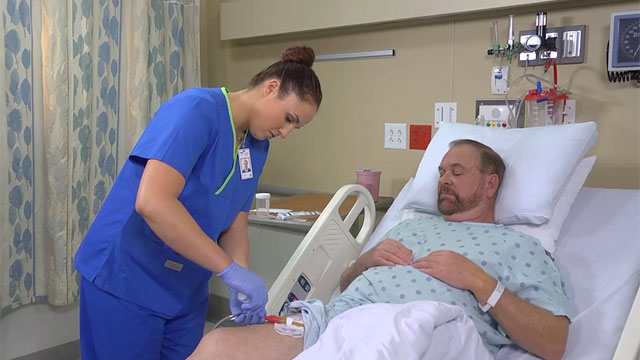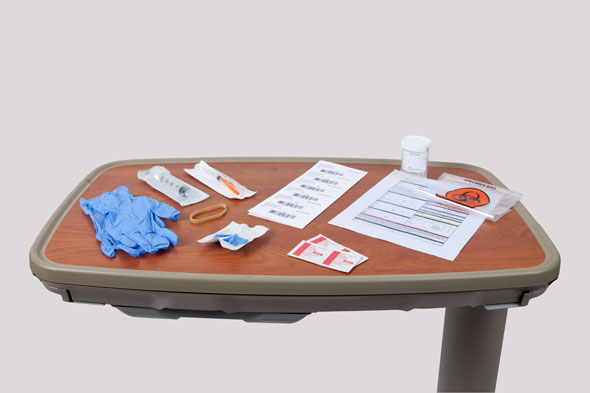Urinary Catheter Management
Select a Skill:
- » Inserting an Indwelling Urinary Catheter in a Female Patient
- » Inserting an Indwelling Urinary Catheter in a Male Patient
- » Irrigating a Urinary Catheter
- » Performing Intermittent Straight Catheterization
- » Obtaining a Specimen from an Indwelling Urinary Catheter
- » Removing an Indwelling Urinary Catheter
- » Caring for a Suprapubic Catheter
Take the Review Test:

Safety
- Follow standard precautions when collecting specimens of blood or body fluids, as well as any additional protective isolation equipment.
- Properly label all specimens with the patient’s identification, date and time the specimen was obtained, the name of the test, and the source of the specimen.
- Deliver the specimen to the laboratory within the recommended time frame, or ensure that it is stored properly for later transport.
Equipment
(Roll cursor over items to see labels)

Completed identification labels
Completed laboratory requisition
Small plastic biohazard bag (or container specified by agency) for delivery of specimen to laboratory
20 mL Luer-Lok for routine urinalysis (or 3 mL safety Luer-Lok syringe for culture)
Alcohol swab
Clamp or rubber band
Specimen container - nonsterile for routine urinalysis or sterile for culture
Clean gloves
Delegation
The skill of collecting urine specimens can be delegated to nursing assistive personnel (NAP). Be sure to inform NAP of the following:
- Indicate when to obtain the specimens. Explain that unclear urine, urine containing blood, urine with excessive sediment, or cloudy urine must be reported to you.
Preparation
- Assess the patient’s or the family members’ understanding of the purpose of the test and the method of specimen collection.
- Assess the patient for signs of a urinary tract infection (UTI), including frequency, urgency, dysuria, hematuria, flank pain, fever, and cloudy, malodorous urine.
- Refer to your agency’s procedures for specimen collection.
Follow-up
- Assess the patient’s tests results.
- Observe the urinary drainage system in the catheterized patient to ensure that it is intact and patent.
Documentation
- Record the collection of a specimen according to your agency’s policy.
- Note the method used to obtain the specimen; the date and time the specimen was collected; the type of test ordered; the appearance, odor, and color of the urine; and the disposition of the specimen to the laboratory.
- Report any abnormal findings to the health care provider.
Review Questions
1. Why does the nurse need to keep the urine sterile while obtaining a sample from an indwelling urinary catheter?
 Sterile technique protects the patient from microorganisms in the urine.
Sterile technique protects the patient from microorganisms in the urine.  Sterile technique protects the nurse from microorganisms in the urine.
Sterile technique protects the nurse from microorganisms in the urine.  Sterile technique reduces the amount of pain caused by the procedure.
Sterile technique reduces the amount of pain caused by the procedure.  Sterile technique ensures that microorganisms in the specimen are from the urine, and not the result of contamination.
Sterile technique ensures that microorganisms in the specimen are from the urine, and not the result of contamination.
2. Which action will ensure that a sterile urine specimen is handled properly in order to help obtain reliable results?
 Placing the specimen in a biohazard bag
Placing the specimen in a biohazard bag  Having someone take the specimen to the lab immediately
Having someone take the specimen to the lab immediately Cleaning the outside surface of the container
Cleaning the outside surface of the container Ensuring that a stock of sterile urine collection kits is available
Ensuring that a stock of sterile urine collection kits is available
3. Which statement might the nurse make to nursing assistive personnel (NAP) before delegating the collection of a routine urine sample from a patient with an indwelling urinary catheter?
 “Does the patient understand why the specimen is needed and why we cannot obtain it from the Foley bag?”
“Does the patient understand why the specimen is needed and why we cannot obtain it from the Foley bag?” “See if the catheter is causing the patient any problems and if he is having any pain.”
“See if the catheter is causing the patient any problems and if he is having any pain.” “Please get two sterile urine collection containers from the utility room.”
“Please get two sterile urine collection containers from the utility room.” “Let me know if the urine contains blood or sediment, or appears cloudy.”
“Let me know if the urine contains blood or sediment, or appears cloudy.”
4. Which measure may be taken to minimize the staff’s risk for infection from a urine specimen?
 Firmly securing the lid of the urine specimen container
Firmly securing the lid of the urine specimen container  Using a sterile urine specimen container
Using a sterile urine specimen container Using a sterile syringe to access the sampling port
Using a sterile syringe to access the sampling port Placing the urine specimen container in the refrigerator until the laboratory comes to get it
Placing the urine specimen container in the refrigerator until the laboratory comes to get it
5. When collecting a urine specimen from an indwelling urinary catheter, which action is most likely to ensure that sufficient urine is collected?
 Checking the patency of the indwelling catheter tubing
Checking the patency of the indwelling catheter tubing Placing the urinary collection bag below the level of the bladder
Placing the urinary collection bag below the level of the bladder Clamping the catheter tubing for 15 minutes before collection
Clamping the catheter tubing for 15 minutes before collection Asking the patient to drink a glass of water 30 minutes before the collection
Asking the patient to drink a glass of water 30 minutes before the collection
You have completed the Review Questions for this skill. To take the Review again select the Start Over button. To proceed to another skill select from the dropdown menu. Select the Home or Back button to proceed to the next section.

